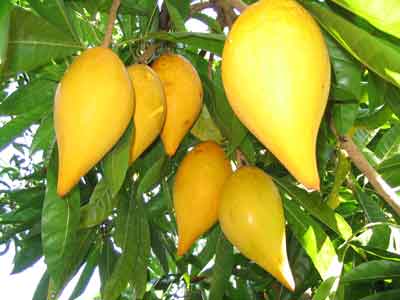From the Archives
of the Rare Fruit Council of Australia
by Gene Joyner, Urban Horticulturist

Canistel
Scientific name: Pouteria campechiana
Family: Sapotaceae

The
egg fruit is one of the nicer, medium-sized tropical fruits for
dooryard plantings in Central and South Florida. This beautiful
evergreen, open-growing tree is native to Central America and can grow
to a height of almost 40 feet if it is not injured by cold weather.
Leaves are 4 to 8 inches long, light to dark green with prominent
veins. Leaves or branches, if cut, have a clear, milky sap which is an
easy way of identification of this tree. Small greenish-white flowers
in small clusters are produced from late spring through early fall and
the fruits mature primarily September through March. The tree has
excellent wind tolerance and fairly good salt tolerance. It is easily
grown over a wide range of soil and moisture conditions, however, it
does prefer the fall season but also some flowering occurs during the
late spring.
Most fruits mature during the fall and winter
months and fruit size is quite variable and also the shape can be quite
different depending on the variety. Most egg fruit vary in shape from
round to shaped like a top and are generally orange or yellow-orange in
color. The fruits can be eaten fresh or they can be used for milk
shakes, pies and other desserts. The fruit has generally a very thin
skin and the color of the egg yolk on the inside (hence the name 'egg
fruit') with the flesh varying from moist and delicious to very dry and
almost inedible. Most egg fruits can be grown very easily from seed,
however, for preferred varieties it is better to graft or air layer.
Most
seeds take 3 to 6 months to come up and take up to 3 to 4 years to
reach bearing age. Some improved varieties are the Ross, Bruce, Aurea,
Joyner everbearing and Hume. Superior varieties are usually grafted or
airlayered. Grafted or airlayered trees usually provide fruit the next
season.
Trees grow quickly, often three to four feet a year,
and prefer slightly acid soils for best growth. On highly alkaline
soils, micronutrient deficiencies may occur which may require treatment
with nutritional sprays. Salt tolerance is fair to good with this tree,
but it should be protected from really exposed areas close to salt
water. Trees are tolerant of cold once they reach 8 to 10 feet but will
get injured at temperatures below 28°F. Young trees should be
protected from temperatures below 30 degrees.
Fertilize egg
fruit trees much like citrus, 3 to 4 times a year with a good balanced
complete fruit tree type fertilizer. Occasionally in the home
landscape, scale insects and rust disease might infest trees but
usually cause no serious problems. Trees tend to be very upright
growing, particularly when small, but can be kept pruned to the size of
a large shrub and still produce abundant quantities of fruit.
Trees
normally have few problems once they are well-established. Occasional
problems such as scale insects may affect trees, but usually these are
not serious enough to kill it. For a medium sized tree that produces
large quantities of fruit, there aren't too many others that can beat
the Canistel/egg fruit.
Back to
Canistel Page
|
|
Bibliography
Joyner, Gene. "Canistel." Archives of the
Rare Fruit Council of Australia, Article
from RFCI Inc. Newsletter, Jan. 1988, July 1988, rfcarchives.org.au. Accessed 23 Dec. 2014.
Photograph
Dott, Chester. "Canistel." Archives of the Rare Fruit Council of Australia, 2006, rfcarchives.org.au. Accessed 23 Dec. 2014.
Published 23 Dec. 2014 LR
|

